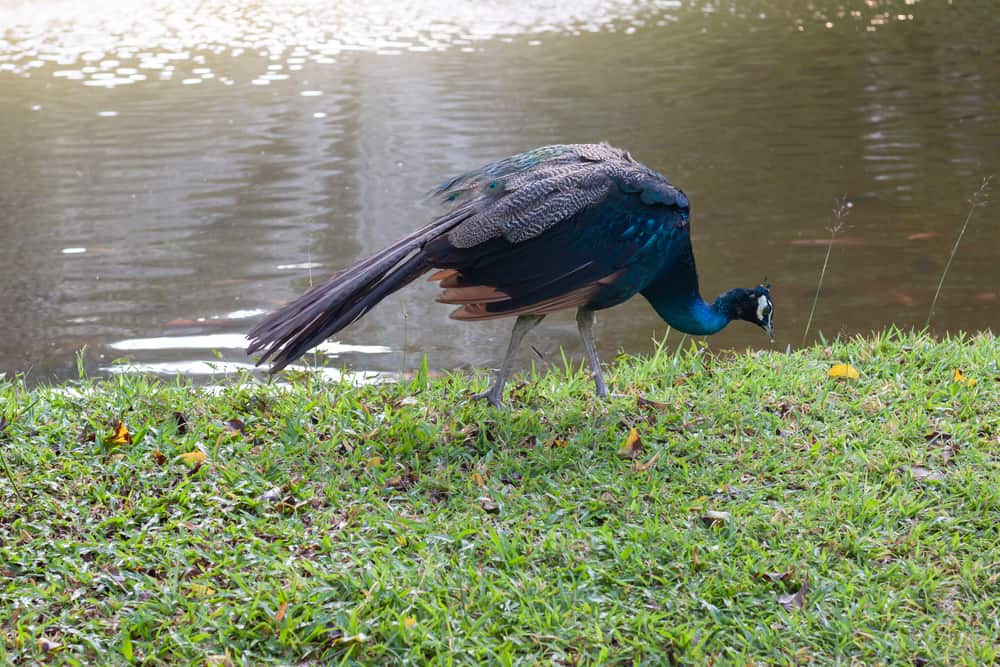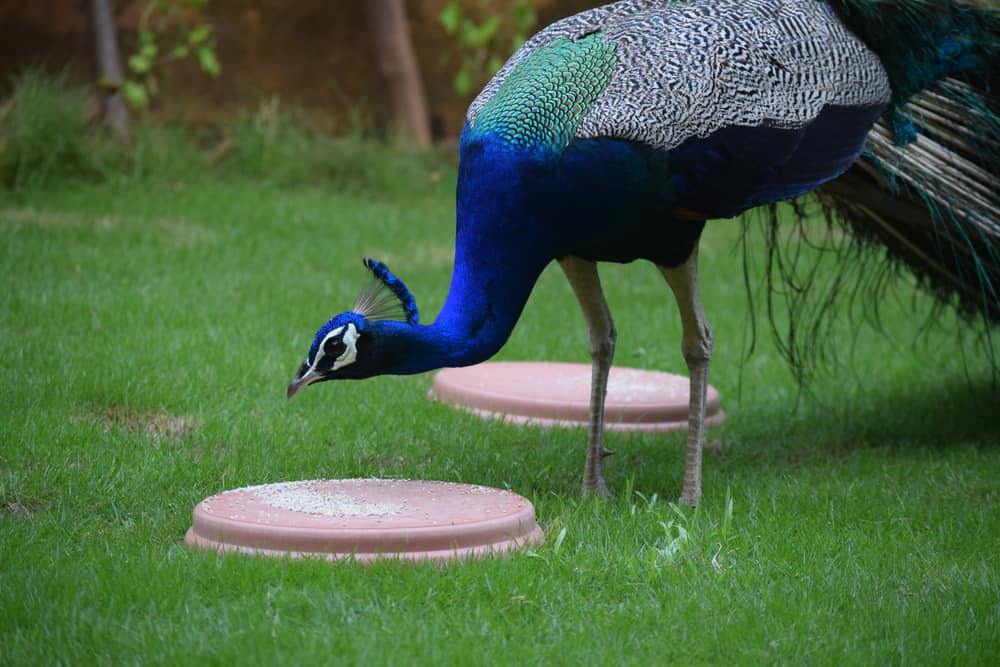That blue or green beautiful bird you’ve seen in pictures, paintings, or even in person. That’s a peacock. Their long multi-colored tail feathers are what capture the attention of most people.
However, many people don’t answer the question, “what do peacocks eat?” This article will provide the answer to this question.
Peacocks Habits and biology
The term peacock is used to refer to the male bird, and the peahens refer to females. The general term to call these birds is peafowls. Now you know!
Three main species of peacocks exist, two of which are native to Asia and one to Africa. These include:
- The blue/Indian peafowl (Paco cristatus) is native to the Indian subcontinent.
- The green peafowl (Pavo muticus) is indigenous to Southeast Asia.
- The Congo peafowl also called the African peafowl, or Bakongo (Afropavo congensis), is native to the Congo basin.
They usually live in forested areas where they hide in tall grass or bushes from their predators. The majority of their day is spent on the ground searching for food.
Despite being big birds, peacocks fly very well. In the night, they fly up tall trees far from the reach of predators where they sleep (roost).
Peacocks have brightly colored plumage (feathers and the way they are arranged), longer tails, and are larger than their female counterparts. Peahens have grey or brownish plumage and shorter tails.
Males make use of their brightly colored plumage and long tail feathers to attract females. On the other hand, females plumage helps them camouflage themselves from predators.
Aside from their brightly colored plumage, peacocks are known for their distinctive noises. They make several different noises, with the most common being their mating call.
Peacocks’ mating call can be heard from miles. During courtships, vocalization is the main way to attract the ‘ladies’. The peacocks will shake their feathers and peck the ground in a way that suggests they are feeding and serenade the peahens with their song. Peacocks typically sing before, during, or after mating
All species of peacocks are polygamous by nature. Females will lay 4-10 eggs yearly. Their young ones, known as peachicks or chicks, remain under the care of their mothers for 7-10 weeks.
Peacocks become sexually active at the age of 2-3 years. Males may take up to 4 years to fully develop their infamous multi-colored tail feathers.
What Do Peacocks Eat In The Wild?
Peacocks are omnivores and will feed on both vegetation and other living creatures. In the wild, peacocks feed on a variety of foods, including:
- Seeds –they commonly enjoy feeding on corn and wheat.
- Plants –peacocks will eat a variety of grasses, Lucerns, and leafy greens.
- Flower petals –they will occasionally search for snails and slugs in these flowers and, in the process, eat the petals of the plant.
- Insects –such as millipedes, centipedes, termites, and small anthropods are eaten most.
- Reptiles –mostly fed on include lizards and even small snakes.
- Amphibians –such as frogs and salamanders, are commonly eaten.
- Fruits and vegetables –they will eat any fruits or vegetables in the wild.
Peacocks in the wild will mostly feed on plants and seeds because as they are easily accesible. However, they prefer to eat insects as they are rich in proteins that are crucial to their plumage formation and development.
They will look for food by scratching around in litters of leaves either early in the morning or later in the afternoon. Peafowls are not picky eaters and will eat almost anything they can fit in their beaks and digest.
When it gets too hot outside, they retreat to shaded areas in the woods. This behavior helps shield them from extreme heat and also from predators.
Peafowls have outstanding eyesight and hearing. They use their superior senses to find small animals to eat. They will sometimes stand on top of tall trees that serve as vantage points for spotting prey. Once they acquire a target, they will swoop in, kill and devour their prey.
When hunting for reptiles and amphibians, peafowls make use of their sharp talons to kill their prey. Their incredible speed and reflexes also come in handy during hunting.
What Do Peacocks Eat As Pets?
Like their counterparts In the wild, peacocks are not picky eaters and will eat practically anything. They will even feed from dumpsters or garbage if not well disposed of.
In captivity, peacocks’ diet is similar to that of peacocks in the wild. The difference is that they don’t have to search for the food. Instead, it is presented to them by their owners.
Peafowls are kept in open areas such as gardens where they are free to forage. They will feed on plants and insects just like those that live in the wild. In addition, they are provided with supplementary foods like cereals to ensure they stay healthy.
These exotic birds can spend the whole day eating as long as there is food available. Below are some examples of foods consumed by pet peacocks.
- Fruits –such as berries, are peafowl’s favorite. They will also eat any other fruit placed before them.
- Grains –Corn and wheat are recommended peafowl food as they provide sufficient energy for these birds to carry out their daily activities.
- Insects –is by far the most essential prey item. You should provide peafowls with insects such as crickets, millipedes, and mealworms, as they are rich in protein.
- Pet food –cat and dog food is highly nutritious and serves as good supplementary food. You should not feed them pet food regularly as they are very salty and fatty.
- Legumes –such as peanuts, beans, and peas also serve as a good source of protein and fats.
- Kitchen scraps –such as cheese rind, carrot pulp, and even chicken bits should not go to waste if you own peafowls.
- Commercial bird feed –act as good supplementary feeds, and they provide these birds with other essential minerals and vitamins that contribute to their overall growth.
- Vegetables –such as cabbage and kales are healthy choices to serve peafowls.
- Small animals –such as mice, are a healthy addition to their diets.
At least 90% of the food offered to peafowls in captivity should be rich in protein. Peacocks kept as pets can’t care for themselves as well as wild peafowls’ do. They are prone to sickness if not fed proper diets.
Pet peafowls are very smart and remember information quickly, especially regarding what goes in their bellies. They remember feeding times in households and will avail themselves in time for feeding every day. How fascinating!
Tips To Feeding Peacocks
Peacocks are fabulous creatures, and they know it. They are friendly towards human beings and can make fantastic pets. Additionally, they also serve as alarm birds as they’ll let you know through the loud noises they produce if an unfamiliar face is on your property.
Caring for them, however, requires some knowledge. They need space –ample space to move around and proper diets to ensure they remain healthy. Below are some pointers to follow when looking after and feeding your pet peacocks.
If you start raising them as chicks, ensure you keep them warm for the first few weeks of their lives.
- During the first 4-6 weeks, the chicks should be kept in an area that reaches 35oC (950F). After that, decrease the temperatures by 50C weekly, depending on the season and where you live.
- Take note of your chick’s behavior to tell if it’s warm or cold. When it is warm, it will move around freely. On the other hand, cold chicks tend to hurdle together to keep warm or keep to a corner.
Build your peafowl a large pen to keep them from flying away.
- The pen should be tall and wide enough to allow them free movement and fan their tail feathers freely. A few rolls of wire mesh should be suitable material for constructing the walls and the roof.
- A wide enough enclosure will help prevent your peafowl from breaking feathers or other injuries.
Don’t allow your peacocks to roam freely. It’s hard for peacocks raised as chicks in a particular area to stray. Despite this fact, if left unsupervised, they may develop behaviors similar to their counterparts in the wild and fly away.
- If you are afraid of losing your exotic birds, keep them within an enclosed area in your property.
If you own many peafowls, avoid overcrowding them. This practice will help prevent an outbreak of diseases and will also keep your birds happy.
- There should be at least a spacing distance of 7 square meters (80 square feet) between each bird.
Provide food and water for your peafowls’ in dishes.
- It would be best to hang the dishes with chains within their enclosure to prevent pests like rats or mice from feeding on their food. By doing so, you also help prevent the peacocks from excreting in their food.
Provide your peahens with a high protein diet for the first three months of their lives.
- Visit any pet store in your area and purchase some game bird feed that should contain at the most 35% protein. As they get older, you should gradually wean them off the game bird feed.
- Too much protein in developing peacocks may lead to severe leg deformities.
Occasionally give your peafowls treats.
- Fruits such as bananas, berries, bread, dog, or cat food are suitable treats for your peacocks. This practice helps prevent them from straying and will also come in handy when getting them to swallow medicine.
Following these steps will help keep your peacocks healthy and live long lives. You won’t worry about them seeking greener pastures by abiding by the above instructions.
Summary
Peacocks are, without a doubt, one of the most beautiful birds to walk this earth. Owning one or several will no doubt make you the talk of the town. Caring for peafowls takes time and effort, but in the end, it’s worth it.
We hope you found this article on” what do peacocks eat?” helpful.

